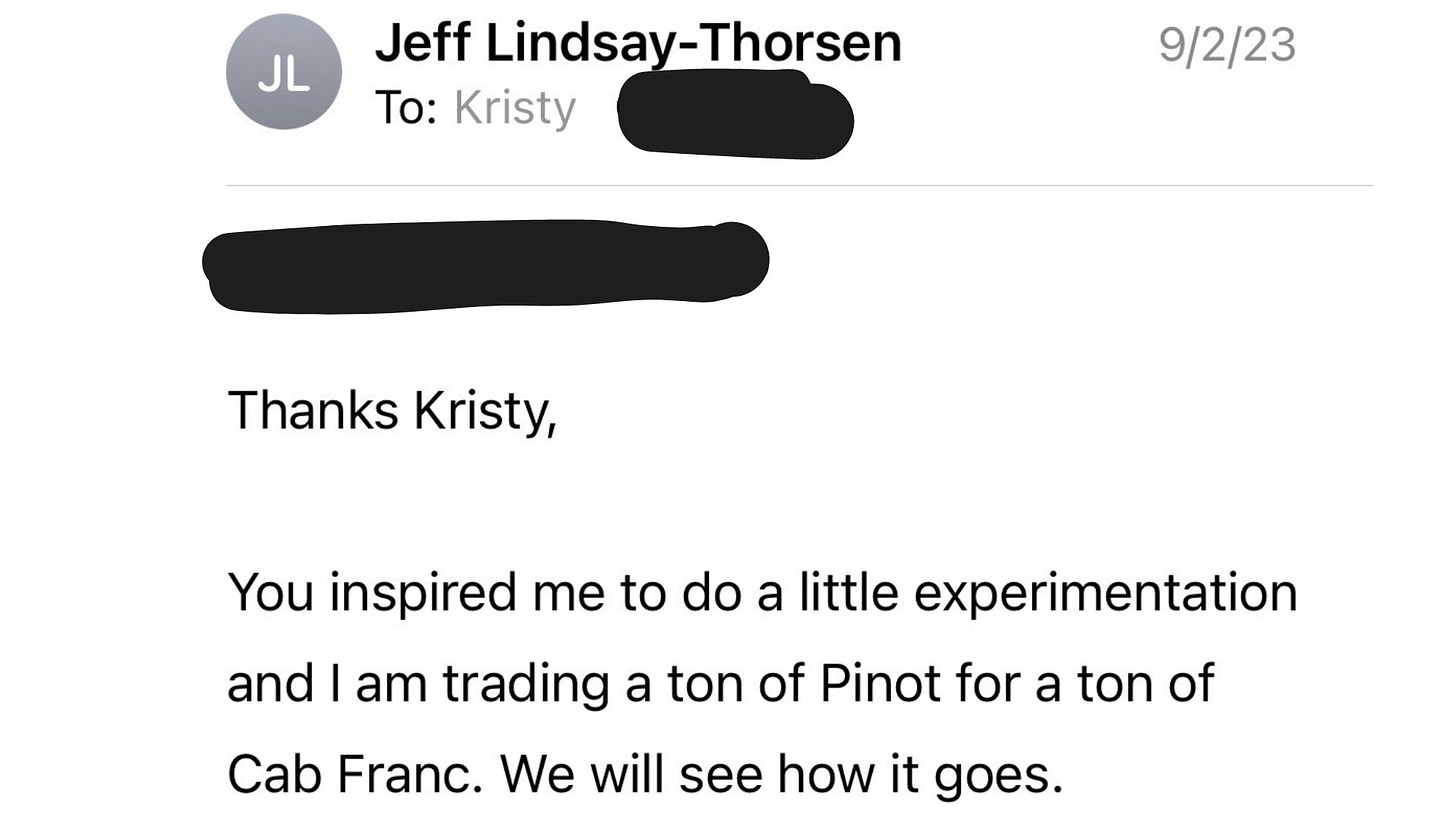Spring break doesn’t have quite the same connotation at 40-something as it did at 20-something, or thereabouts, but at least there’s better juice in the glass and foosball is still freakin’ competitive. Speaking of, here are a few wines to help you ring in warm-“ish” days, give you that liquid-courage kind of edge at the foosball table, or celebrate/mourn your March Madness brackets (no red Solo cups required):
In My Glass
You had me at Meunier, which makes up 80% of this explosively aromatic Champagne, while Chardonnay provides that lofty, freshness. From four hectares in the Massif de Saint-Thierry, Champagne’s northernmost region, Champagne Ullens crafts this blend entirely in oak sourced from local forests and draws from reserves dating back to 2016. After three years in the bottle and hand-riddling, this bubbly got a small dosage of around 3 g/L. The result, a powerfully aromatic display followed by a chalky, voluptuous palate with red apple, citrus, brioche, and roasted hazelnut. Unlike the Illini-UConn match-up, you won’t want to forget this one (says an Illini fan). Draft pick. $88
*I predict Champagne Ullens is one to start collecting now, if that’s your thing.
2022 Ermes Pavese Valle D'Aoste “Blanc de Morgex et de la Salle”
If you spend a few minutes around a Somm or a wine geek, it’s likely you’ll hear the term “high-elevation,” and for good reason. A lot of great wines are grown in high-places. It can be beneficial for growing grapes with notable acidity, aromatics, structure, and concentration.
You might also hear the words “own-rooted” or “pre-phylloxera vines” mentioned with esteem as well. And considering American vines nearly wiped out every vineyard in Europe in the mid-1800s with this vine-destroying louse, before later saving them via root grafting European vitis vinifera vines to American rootstock (American grape vines are resistant to the menacing bug), it’s no wonder. Own-rooted vitis vinifera vines are a rare find around the world, and even more so in Europe.
So, long story short: this 300-case production wine, from an Alpine grape known as Prié Blanc, grown almost exclusively in the Valle d'Aosta DOC of northwest Italy (bordered by Switzerland and France), comes from own-rooted vines on an organic vineyard site at a 1,200-meter (3,400-foot) summit of Mont Blanc. That’s some high-elevation folks!
A steely, extremely aromatic, mineral-driven white wine with crushed rocks, craggy mountain herbs (think sage, thyme, rosemary, lavender - aka garrigue), orchard flowers, and white peach. It’s more savory than fruity, but still manages to make your mouth water and leave you with a lingering pristine freshness. Lofty. $39
2020 Domaine Gayda Figure Libre Cabernet Franc
Winemaker Vincent Chansault is coming out to play with this ode to Loire from Languedoc’s Brugairolles. This Cabernet Franc from the sandstone soils just south of Carcassonne, France is a perfumed, juicy, and intense red that’s as easy on the palate as it is the wallet. Black cherries and currants, spice, and graphite dominate, but every now and then a hint of roasted bell pepper reminiscent of Chinon sneaks through. It may not be a grape “permitted” by this appellation in southern France, but I’m thankful for Chansault’s rebel spirit. Jack Kerouac. $35
In the Spotlight
Region of the Week
The Columbia Gorge AVA is the western-most appellation in eastern Washington and one of three AVAs that cross into Oregon. It’s also one of Washington’s only growing regions that lies outside of the expansive Columbia Valley appellation.
Named for the 40-mile area where the Columbia River cuts through basalt bedrock, creating a series of ridges and cliffs, the Columbia Gorge is notable for its soil, elevation, and climate diversity.
Here you’ll find cooler, maritime areas to the west and more continental, hot, dry regions to the east. In fact, if you drive west to east in the AVA, the annual rainfall decreases about one inch per mile with the western section receiving an average of 36 inches of rainfall annually (making it one of the only regions in the state where dry farming is possible) and the eastern area only about 10 inches.
The Columbia Gorge is the only sea-level passage through the Cascade Mountains, pushing through winds at an average speed of 10-20 miles per hour - and believe me, it is windy! These near-constant winds are caused by the pressure differentials between the cool air from the Pacific and warm air from eastern Washington’s deserts.
There are more than 50 grape varieties grown here across some 90+ vineyards, totaling 1300 acres vineyards. And as for the 50 wineries in the AVA, most are producing less than 5000 cases.
Recommended wineries to visit on the Washington side of the river: Syncline Winery and COR Cellars.
Recommend wine bars to visit in White Salmon, Washington: Soča Wine Shop & Bar and CLYZM Wines.
Recommended wines to source: Gorgiste’s Gamay Rosé and Gamay Noir as well as their Chardonnay. And keep your eyes out for a Cab Franc I may have inspired!
Recommended place to stay (hands-down): White Salmon White House Mountain Retreat
Winery of the Week
We have a rule: one wine club per year.
When we moved to Willamette Valley, we immediately joined a local club for access to some of our favorite Chardonnay. A few months later, we stopped off at Syncline Winery in the Columbia Gorge on our way home from a concert at The Gorge (another must if you’re into live music in insanely beautiful places with incredible acoustics). Maybe it was the Rhône/Languedoc grape varieties (Grenache, Syrah, Mourvedre, PicPoul), or the fact that vigneron/co-founder James Mantone is from Chicago and went to school for wine/geology in Michigan, but we broke our rule. That said, it’s now the only club we belong to and I don’t see that changing anytime soon.
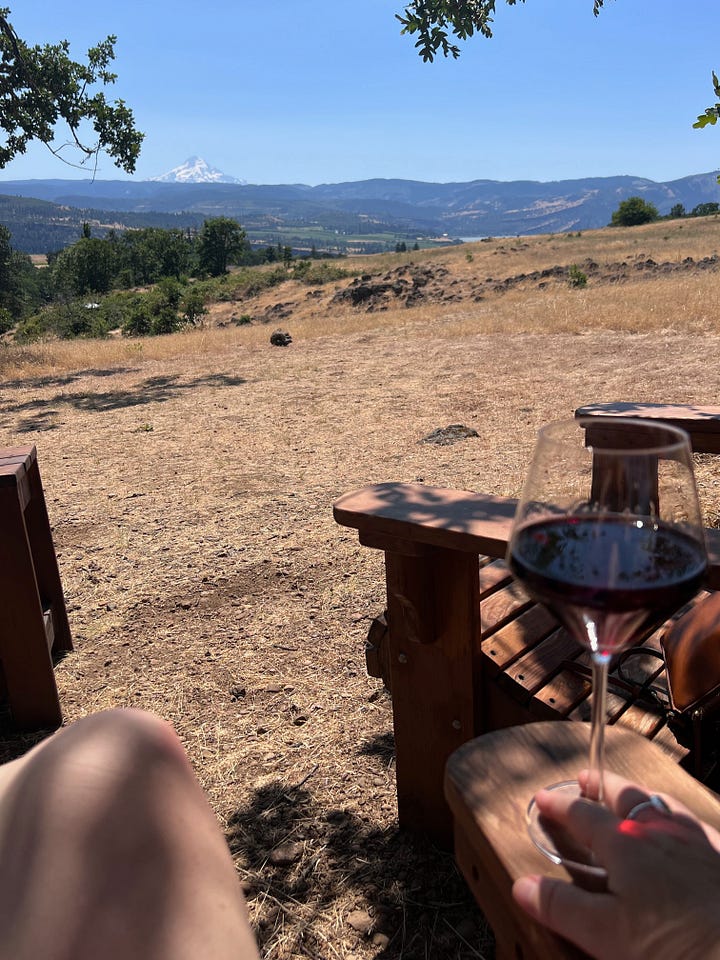
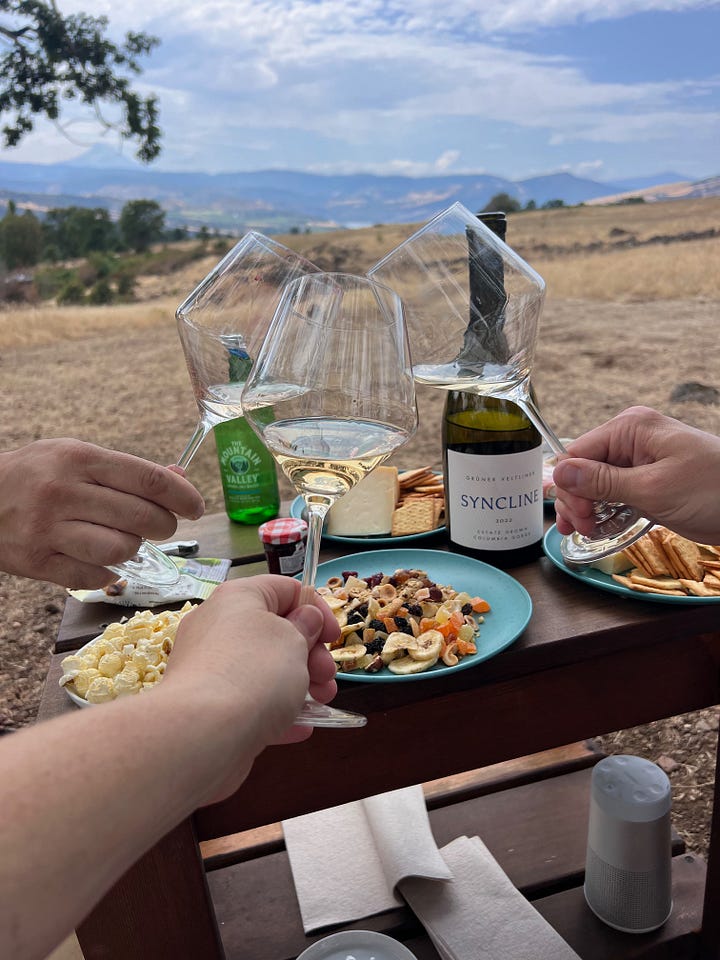
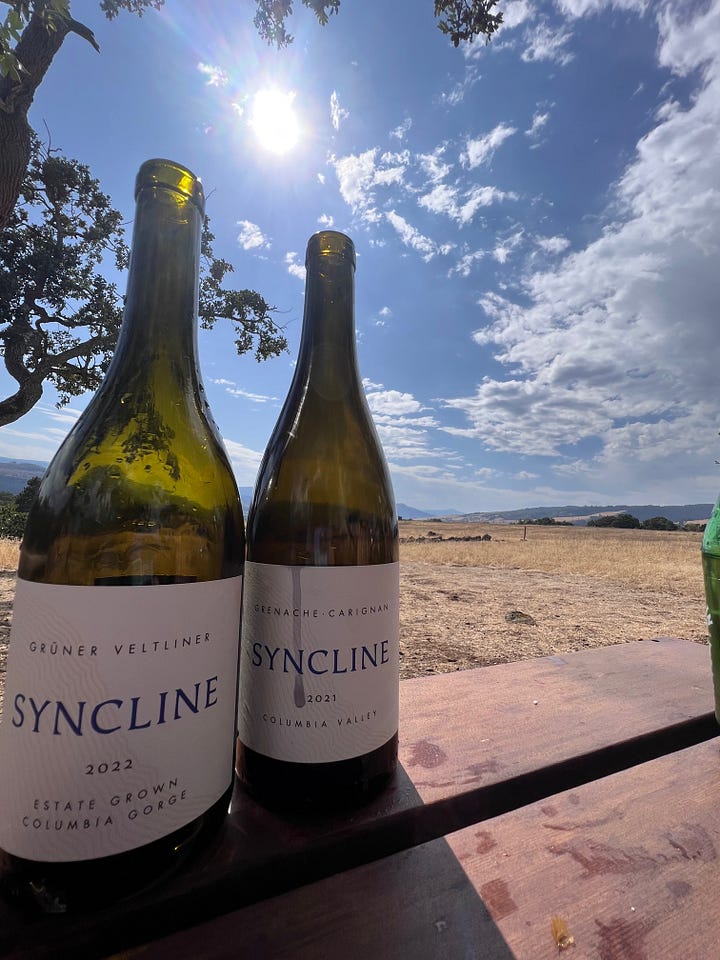
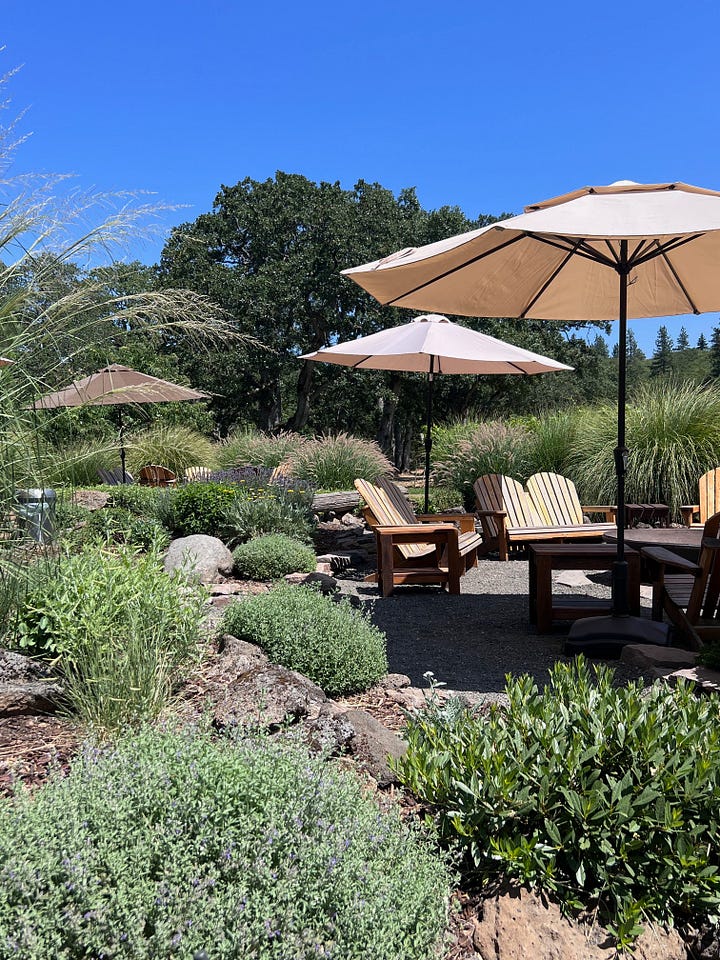
syncline (‘sin-klin) - a trough of stratified rock in which the beds dip toward each other from either side.
Fitting for the Gorge. Syncline’s co-founders Poppie and James Mantone met during the harvest of 1997 while working together in a cellar in the Willamette Valley. Shortly after, they fell in love and began plans for a new endeavor: a vineyard of their own. Their passion for Rhône and sparkling wines led them to the Columbia Gorge in Washington State where they became part of the small group that founded the Columbia Gorge AVA in 2004.
Celebrating the 25th anniversary of Syncline this year, they continue to specialize in limited-production wines with a focus on those Rhône varieties and sparkling bottlings. They maintain 19-acres of biodynamic estate vineyards and also work with winegrower partners in other Washington AVAs including Red Mountain, Yakima, and Horse Heaven Hills. Their production remains under 5,000 cases allowing an intimate connection to each and every tank and barrel.
Wines are available for shipping in most states, but if you’re in the area, do stop in for a visit. I’d make specific recommendations, but honestly, I haven’t disliked a wine yet. That said, this Syrah. And I’m not alone in saying that…
“Everything I LOVE about Syrah from the West Coast. Plenty of cool raspberry and blackberry flavors along with a touch of leather and pepper.” — Matthew Horkey
Did You Know
One of the most common misperceptions I heard in the wine classes I taught - and honestly I had the same one myself once upon a time - is that Washington’s Columbia Valley and Willamette Valley, Oregon were lumped into the same Pacific Northwest cool climate.
And yes, they are obviously both in the Pac Northwest, but the climates are vastly different. In Washington’s Columbia Valley it’s a high desert scenario with very hot days followed by very cool nights. That diurnal temp swing (sometimes as much as 50-degrees between day and night) is key for maintaining acidity in the grapes.
Throughout the Columbia Valley you’ll find a basalt foundation resulting from lava flows, glacial slack water deposits from the Missoula floods, and loess and free draining, nutrient poor soils making up the majority of the rest.
The Missoula Floods transformed the Pacific Northwest landscape. Geologists estimate that the floods occurred several times over the 2,000-year period between 15,000 and 13,000 years ago and that each flood and reformation spanned 55 years.
In summary, these porous and well-draining soils are ideal for growing grapes and they provide a source of minerals to help the vines thrive. And the desert climate also promotes the balanced ripening of the grapes growing here.
The other thing I taught in my classes - Washington Syrah is where it’s at! (Among other Rhône, Languedoc, and Bordeaux varieties).
Spring Broke
Do not try this at home (bts footage for paid subscribers):
Keep reading with a 7-day free trial
Subscribe to Kristy's Wine Travels to keep reading this post and get 7 days of free access to the full post archives.






